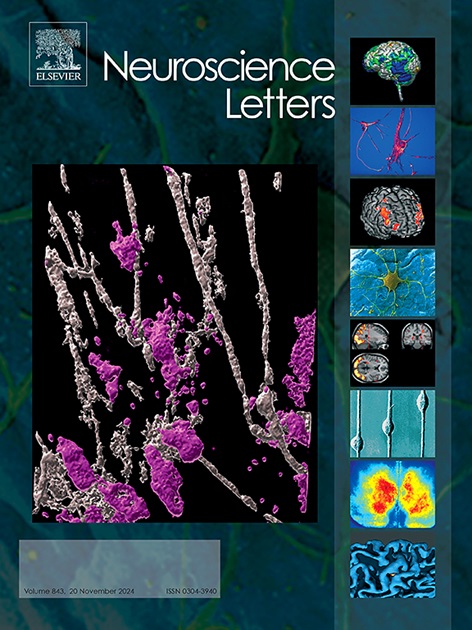在帕金森病小鼠模型中,亚区域特异性抑制多巴胺D1受体表达可预防左旋多巴诱导的运动障碍
IF 2
4区 医学
Q3 NEUROSCIENCES
引用次数: 0
摘要
左旋多巴诱导的运动障碍(LID)是帕金森病(PD)患者长期左旋多巴治疗后出现的一种衰弱性运动并发症。纹状体D1型/直接通路中棘神经元(MSNs)多巴胺D1受体(DRD1)信号的异常激活在LID的病理生理中起关键作用。我们之前在7个纹状体亚区表征了DRD1信号,并发现在PD小鼠模型中,DRD1信号在中间/尾侧(IC)的上调与LID相关。在这里,我们研究了DRD1在IC中的表达是否在LID的发展中起因果作用。利用一种表达短发夹RNA的腺相关病毒(AAV- shdrd1),我们选择性地敲低了雄性小鼠IC中Drd1的表达。在单侧6-羟多巴胺损伤小鼠中,急性和慢性左旋多巴治疗后,IC中DRD1的敲低显著减弱了LID。相比之下,在吻侧或中间/吻侧部分(之前被确定为与LID无关的亚区)的敲低对LID没有影响。这些发现强调了DRD1及其信号在LID发展过程中IC中的重要作用,为开发新的治疗方法提供了有价值的见解。本文章由计算机程序翻译,如有差异,请以英文原文为准。
Subregion-specific suppression of dopamine D1 receptor expression prevents L-DOPA-induced dyskinesia in a mouse model of Parkinson’s disease
L-DOPA-induced dyskinesia (LID) is a debilitating motor complication that develops following prolonged L-DOPA therapy in patients with Parkinson’s disease (PD). Aberrant activation of dopamine D1 receptor (DRD1) signaling in D1-type/direct pathway medium spiny neurons (MSNs) of the striatum plays a critical role in the pathophysiology of LID. We previously characterized DRD1 signaling in seven striatal subregions and found that upregulation of DRD1 signaling in the intermediate/caudal part (IC) is associated with LID in a mouse model of PD. Here, we investigated whether DRD1 expression in the IC plays a causal role in LID development. Using an adeno-associated virus (AAV) expressing a short hairpin RNA against Drd1 (AAV-shDrd1), we selectively knocked down DRD1 expression in the IC of male mice. In unilateral 6-hydroxydopamine-lesioned mice, DRD1 knockdown in the IC significantly attenuated LID after acute and chronic L-DOPA treatment. In contrast, knockdown in either the rostral or intermediate/rostral part, previously identified as the LID-unrelated subregion, did not affect LID. These findings highlight the essential role of DRD1 and its signaling in the IC in LID development, providing valuable insights for developing novel therapeutic approaches.
求助全文
通过发布文献求助,成功后即可免费获取论文全文。
去求助
来源期刊

Neuroscience Letters
医学-神经科学
CiteScore
5.20
自引率
0.00%
发文量
408
审稿时长
50 days
期刊介绍:
Neuroscience Letters is devoted to the rapid publication of short, high-quality papers of interest to the broad community of neuroscientists. Only papers which will make a significant addition to the literature in the field will be published. Papers in all areas of neuroscience - molecular, cellular, developmental, systems, behavioral and cognitive, as well as computational - will be considered for publication. Submission of laboratory investigations that shed light on disease mechanisms is encouraged. Special Issues, edited by Guest Editors to cover new and rapidly-moving areas, will include invited mini-reviews. Occasional mini-reviews in especially timely areas will be considered for publication, without invitation, outside of Special Issues; these un-solicited mini-reviews can be submitted without invitation but must be of very high quality. Clinical studies will also be published if they provide new information about organization or actions of the nervous system, or provide new insights into the neurobiology of disease. NSL does not publish case reports.
 求助内容:
求助内容: 应助结果提醒方式:
应助结果提醒方式:


